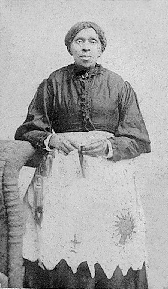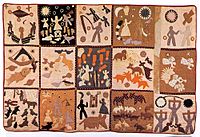Harriet Powers facts for kids
Quick facts for kids
Harriet Powers
|
|
|---|---|

Photograph of Harriet Powers (1901)
|
|
| Born |
Harriet Powers
October 29, 1837 |
| Died | January 1, 1910 (aged 72) |
| Nationality | American |
| Known for | Quilting |
|
Notable work
|
Bible Quilt 1886 Pictorial Quilt 1898 |
Harriet Powers (born October 29, 1837 – died January 1, 1910) was an amazing American folk artist and quilter. She was born into slavery in rural Georgia. She got married when she was young and had a big family.
After the American Civil War ended, she and her family became free. They even owned land by the 1880s. Sadly, they later lost their land because of money problems. Harriet Powers used a special sewing method called appliqué to make her quilts. Her quilts told stories from the Bible, local legends, and even about space!
Only two of her beautiful quilts are still known today. They are called Bible Quilt 1886 and Pictorial Quilt 1898. Her quilts are thought to be some of the best examples of quilting from the 1800s in the Southern United States. You can see her work at the National Museum of American History in Washington, D.C. and the Museum of Fine Arts in Boston, Massachusetts.
Contents
Biography
Harriet Powers was born into slavery in 1837 near Athens, Georgia. She likely learned to sew from other enslaved people or from the women who enslaved her. This was probably on a plantation in Madison County.
In 1855, when she was 18, Harriet married Armstead Powers. They had at least nine children together.
Life After Slavery
After the American Civil War, Harriet and her family became free. In 1870, records show they owned personal items worth $300. They did not own land yet. Harriet was listed as 'keeping house,' and Armstead worked as a 'farmhand.'
By the 1880s, the Powers family owned four acres of land. They ran a small farm in Clarke County. In 1886, Harriet showed her first quilt at the Athens Cotton Fair.
Later, Armstead started selling parts of their land because of money troubles. Even though they had financial problems, they did not lose their home. It was hard for African Americans in their area to get enough cash for taxes.
In 1894, Armstead left Harriet. She never remarried. She probably worked as a seamstress to support herself. She lived in Clarke County for most of her life.
Harriet's Education
Some people thought Harriet Powers couldn't read or write. But a quilt historian named Kyra E. Hicks found a letter written by Harriet. This letter showed that Harriet was able to read and write.
The letter also shared details about her life when she was enslaved. It described how and when she learned to read and write. Harriet wrote that she learned Bible stories by studying the Bible herself.
Harriet Powers passed away on January 1, 1910. She was buried in the Gospel Pilgrim Cemetery in Athens. Her grave was found again in 2005.
Career as a Quilter
Harriet Powers showed her first quilt, The Bible Quilt, in 1886. This was at the Athens Cotton Fair. Jennie Smith, an artist and teacher, saw the quilt there. She thought it was amazing and wanted to buy it.
Harriet did not want to sell it at first. But they stayed in touch. Four years later, Harriet needed money. She offered to sell the quilt to Jennie for ten dollars. Jennie agreed but paid five dollars instead. Harriet explained all the pictures on the quilt to Jennie. Jennie wrote down what Harriet said in her diary.
Harriet's second quilt, The Pictorial Quilt, was made in 1898. Its story is a bit unclear. Some say it was ordered by wives of teachers at Clark Atlanta University. They had seen her first quilt at an exhibition in 1895. Another story says the quilt was bought in Nashville, Tennessee, in 1898.
This quilt was given to Reverend Charles Cuthbert Hall of New York City. He was a leader at Atlanta University. His family later sold the quilt to a collector named Maxim Karolik. He then gave it to the Museum of Fine Arts, Boston.
Harriet also described another quilt in a letter from 1896. She called it The Lord's Supper Quilt. We don't know if this quilt or any others she made still exist today.
Her Famous Quilts
Bible Quilt 1886
The Bible Quilt was finished in 1886. It is about 88 by 73 inches in size. It is made from cotton cloth. The quilt has 11 panels, or squares, arranged in three rows.
Some scenes are larger than others. The quilt looks like the scenes are placed randomly, but they tell a story in a line. Harriet made The Bible Quilt using appliqué techniques. She sewed it both by hand and with a machine.
The panels show stories from the Bible. For example, there is Jacob and his ladder. This Old Testament story was popular with enslaved people. They felt like Jacob, who was hunted and homeless. The ladder meant escaping from slavery.
Other scenes include Adam and Eve, Satan, Cain killing Abel, and Job. There is also Jonah and the Whale, the Baptism of Christ, and the Crucifixion. Other panels show Judas Iscariot, the Last Supper, and Christ going to Heaven. Harriet Powers may have chosen these stories to share secret messages about loss and escape.
Jennie Smith, an artist, saw the quilt in 1886. She wrote that Harriet's style was "bold" and "delicious." Harriet did not want to sell it then. But four years later, she sold it because her family needed money. She explained each panel to Jennie, who wrote it down. Harriet visited the quilt many times while Jennie owned it. This shows how important it was to her.
Where to See It
The Bible Quilt was given to the Smithsonian Institution. It is now on display at the National Museum of American History.
Pictorial Quilt 1898
The Pictorial Quilt was finished in 1898. It is about 68 by 105 inches. It is also made from cotton using appliqué techniques. This quilt has 15 squares, all the same size. They are arranged in three rows of five.
There are 10 Bible stories, four historical scenes, and one lesson about right and wrong. The scenes are not in order. They mix Bible stories with historical events.
The Bible stories include God creating animals in pairs. Other stories are Adam and Eve, Moses and the serpent, and Jonah and the whale. There are also scenes of Job praying and angels. Two scenes show parts of Jesus's life.
The four historical panels show natural events that impressed people. Some happened before Harriet was born. For example, Panel 2 shows "The Dark Day" of May 19, 1780. On that day, the sky became very dark. This was caused by smoke from forest fires in Canada.
Panel 8 shows the Leonid meteor shower of 1833. Panel 11 shows 'Cold Thursday,' February 10, 1895. Harriet shows people frozen in place. Panel 12 shows the Red Light Night of 1846.
Panel 13 teaches a lesson about right and wrong. It shows two rich people who were punished for not knowing God. This panel also shows a hog that supposedly walked from Georgia to Virginia.
Where to See It
Reverend Charles Cuthbert Hall was given the quilt in 1898. It was a gift from women at Atlanta University. His son later inherited it.
Collectors Maxim and Martha Karolik bought the quilt in 1964. They then gave it to the Museum of Fine Arts, Boston. You can see it displayed there.
Harriet Powers' Artistic Style
Harriet Powers' quilts show stories from the Bible and historical events. They also show things happening in the sky. Both of her quilts were sewn by hand and machine. She used appliqué and piecework methods. These methods show influences from both African-American and African art. Her quilts are known for their bold use of these techniques and for telling stories.
Jennie Smith wrote down what Harriet Powers said about each square of The Pictorial Quilt. For example, about the falling stars square, Harriet said, "The people were frightened and thought that the end of time had come. God's hand staid the stars. The varmints rushed out of their beds."
Art experts have noticed how similar Harriet's quilts are to West African wall hangings. Like art from Benin, her work uses simple symbols that don't change much. For example, most of the people in The Bible Quilt look like they were made from the same pattern. Men and women are shown differently by a V-shape cut from the skirt.
Her pictures of people, animals, and objects are simple. They capture the main idea of the figure. This style is like art made by the Fon, Asante, Fante, and Ewe people.
Some people think Harriet's interest in space and religious stories came from her community. They shared information during quilting parties. They heard sermons every Sunday. This information then became part of her quilts.
Other experts believe her interest in space might have been religious. Or it could have been linked to a special group. We know Harriet could read. But she might have also used her quilts to teach. Many people in her community could not read.
Honors After Her Death
In 2009, Harriet Powers was added to the Georgia Women of Achievement Hall of Fame. This is a special honor for women from Georgia.
In October 2010, groups in Athens, Georgia, held events to celebrate Harriet Powers. They called it "Hands That Can Do: A Centennial Celebration of Harriet Powers." There was a quilt show, storytelling, a gospel concert, and a special church service. People also visited Harriet Powers' grave.
The mayor of Athens-Clarke County, Heidi Davison, declared October 30, 2010, as Harriet Powers Day.
In Popular Culture
Children's Books
- Fader, Ellen. (March 1, 1994). "Stitching Stars: The Story Quilts of Harriet Powers", The Horn Book Magazine.
- Herkert, Barbara, and Vanessa Brantley-Newton (illustrator). Sewing Stories: Harriet Powers' Journey From Slave To Artist. New York: Knopf Books for Young Readers, 2015.
- Lyons, Mary E. Stitching Stars: The Story Quilts of Harriet Powers. New York, NY: Aladdin Paperbacks, 1997.
Quilt Patterns
- Powers, Harriet. A Pattern Book: Based on an Appliqué Quilt by Mrs. Harriet Powers, American, 19th Century. Boston: Museum of Fine Arts, 1970.
- Perry, Regenia. Harriet Powers's Bible Quilts. New York: Rizzoli International, 1994.
- Hicks, Kyra E. The Lord's Supper Pattern Book: Imagining Harriet Powers' Lost Bible Story Quilt. Arlington: Black Threads Press, 2011.
Theater
- Cavalieri, Grace. Quilting the Sun. This play was ordered by the Smithsonian Institute. It was first performed in New York City in 2002.
See also
 In Spanish: Harriet Powers para niños
In Spanish: Harriet Powers para niños
- African-American art
- Baltimore album quilts
- History of quilting
- Quilting
- List of slaves
- The Quilts of Gee's Bend



